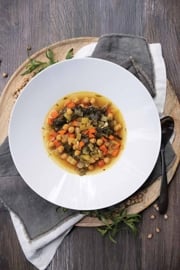Basic Seitan

If you have difficulty locating store-bought seitan (generally sold in 8 oz/225 g packages in the refrigerator section of health food stores), you can easily (and inexpensively) make your own for use in these and many other recipes. This recipe uses a little bit of chickpea flour to act as a tenderizer and to add fibre.
Broth:
6 cups (1.5 L) water
2 Tbsp (30 mL) dark molasses
1/4 cup (60 mL) low-sodium soy sauce
2 Tbsp (30 mL) grated fresh ginger or chopped garlic (optional)
Dry mixture:
2 cups (500 mL) vital wheat gluten (see sidebar)
1/4 cup (60 mL) chickpea flour (besan)
2 Tbsp (30 mL) nutritional yeast flakes
1 tsp (5 mL) garlic powder
1 tsp (5 mL) onion powder
2 cups (500 mL) cold water (The water must be cold; hot water makes seitan stringy.)
Bring broth ingredients to a boil in large pot.
While broth heats up, whisk together vital wheat gluten, chickpea flour, nutritional yeast, garlic powder, and onion powder in medium bowl. Pour in cold water and stir until mixture comes together, then knead lightly with hands (in bowl) until it feels a bit springy.
On sheet of baking parchment, divide dough in half and roll each half into 18 in (45 cm) long log. With sharp knife, cut each log into 32 equal-sized pieces.
When broth is boiling quickly drop in gluten pieces. Turn down heat until broth keeps a low, steady simmer. (Boiling makes seitan spongy.) Simmer for 1 hour. Cool seitan in broth, then remove with slotted spoon and divide into meal-sized quantities. Freeze in airtight containers for future use.
Makes 64 pieces; serves 8.
Using Basic Seitan in recipes
To substitute Basic Seitan for store-bought seitan in recipes, refer to the following conversions:
- ?4 oz (115 g), use 6 to 7 pieces
- 8 oz (225 g), use 13 pieces (This is equal to a typical store-bought package.)
- 10 oz (285 g), use 16 pieces
- 12 oz (340 g), use 20 pieces
- 14 oz (400 g), use 23 pieces
- 16 oz (450 g), use 26 pieces.
source: "Seitan", alive #358, September 2012




